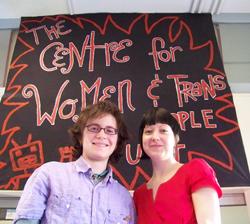When trans man Claro Cosco and ally Michelle Pettis started the Trans Film Night in Spring 2008, they never thought it would grow into what it has: a 100-person event where trans identities are celebrated on screen and with community.
“It was a way to team the inclusion we were trying to build out of the policy and put that into action. It is the social element beyond the paper element,” says Pettis.
“We got bored of all the paperwork and the bureaucracy stuff, and we were dreaming of fun things that we could do to get people involved in the centre, make it exciting and do stuff, and we were like, “Oh, we should show movies.” And we just started showing movies, and it organically became this thing really quickly. It was super exciting to see it turn into this film night event that was happening,” said Cosco.
Starting out as a weekly session with a small group of friends, where the duo showed every trans film they could think of, the night has turned into a much-anticipated monthly event. A constant question asked since it’s beginning is, “When is the next one?”
Eventually, with both Cosco and Pettis in school, showing a film once a month became more sustainable. (During the summer, the film night is bimonthly.)
“The social element is political too. To be able to create a space where trans folk and allies come together, that’s a political movement in itself,” said Pettis.
The duo aim to challenge representations of trans people in dominant media as well as provide a place where trans people can see themselves in film in a positive light.
Folks are making a habit of attending, including Stefoknee Wolscht and Savanaugh Garmon.
“It is very emotional to watch on the big screen another person experiencing the same fear, hurt, shame, joy and satisfaction for identifying as trans as I have witnessed firsthand. There is an even greater joy in seeing the response of those that do not identify as trans, as they begin to relate to how I feel,” says Wolscht.
What I like about the Trans Film Night is that these are films that are made either with participation of trans people, or express the point of view of a trans person or have trans people as characters. So that in one way or another the viewer gets to explore trans identity,” says Garmon.
At the end of the day, the film night is about celebrating trans identities.
“So often trans stuff is couched in terms of medicalization or like really draining activism where you’re fighting against something really big and there’s not a lot of room for celebration and what that looks like. That’ll burn you out. This is more like a recharging of space. Celebratory is how I see it,” said Cosco.
The next film night will be April 8. Kinky Boots, a British comedy, will be shown at the Centre for Women and Trans People U of T, 563 Spadina Ave, Room 100 (north of College, east side of Spadina), 416-978-8201, womenscentre.sa.utoronto.ca. Look out for a Pride Trans Film Night event in June.

 Why you can trust Xtra
Why you can trust Xtra


